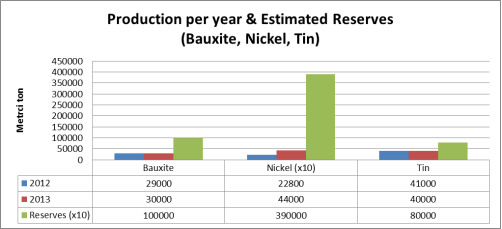Economic Impact of the Indonesian Mineral Law
Causes of the 2008 Global Economic Crisis
September 21, 2022Conflict and Natural Resources Relationship to Growth
September 21, 2022Economic Impact of the Indonesian Mineral Law
Abstract
Raw mineral ores is one of excellence natural product in Indonesia. For many years, the mineral mining company in Indonesia can export raw mineral ores directly over the world. A new mining law mandates the mining company to process the ores domestically then export its product. The government purpose is to increase value added of the mineral ores and creates domestic industry activity. The problem arises since there are only few smelters which ready to process the mineral ores. In short run, this new law has a negative impact to mineral export activity and GDP growth become slower.
1 Introduction
Indonesia is one of rich countries with abundant mineral resource. Bauxite, copper, gold, nickel and tin are Indonesia’s excellence mineral resource export product. This mineral ores are spread over in Indonesia region, mostly in Kalimantan Island, Papua Island, Sumatra Island and Sulawesi Island.
The latest report of U.S. Geological Survey (USGS) mentions the estimation of bauxite reserves in Indonesia is 1,000,000 metric ton, ranked Indonesia in 6th of biggest bauxite reserves in the world. Meanwhile the reserve of Indonesia’s copper is 28,000 metric ton, the 8th largest in the world. Gold reserve is 3,000 metric ton, placed in 5th largest reserves in the world. Other Indonesia resources, nickel and tin are estimated 3,900,000 and 800,000 metric ton reserved beneath the earth. Indonesia’s nickel is 6th largest deposit and tin reserve ranked this country at 2nd position in the world (USGS, 2014).

Figure 1.Production per year & its reserves (bauxite, nickel, tin) (source: USGS, 2014)

Figure 2.Production per year & its reserves (copper, gold) (source: USGS, 2014)
These generous resources are being used by Indonesian government to add national income by export the mineral ores to foreign country. Since 1967, Indonesian government attracts foreign company to invest in mining sector. To regulate the Foreign Direct Investment (FDI) in mining sector, the government had been issued several mining law which has revised over the time. Since then, the mining sector is become favorite among foreign investor (Bhasin & Venkataramany, 2007).
If you need assistance with writing your essay, our professional essay writing service is here to help!
These mining activities contribute to Indonesia’s Gross Domestic Product (GDP). Together with oil & gas and quarrying, mining sector accounted with 7% in real GDP at 2012 (at constant prices). Even though this sector does not contribute more in contrary with another natural resource e.g.: agriculture, livestock, forestry and fishery with 12% contribution in GDP, mineral sector still contribute USD 61.3 billion in Indonesia’s total GDP of USD 875.72 billion

